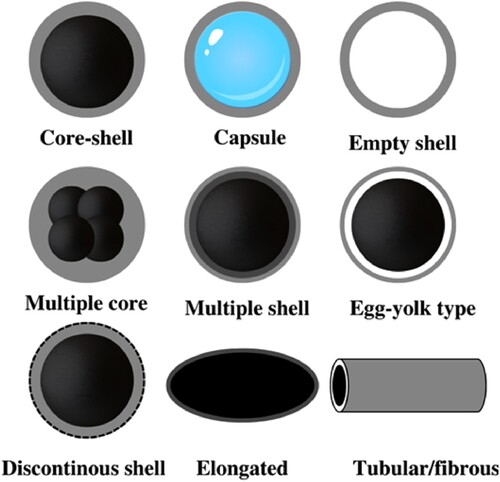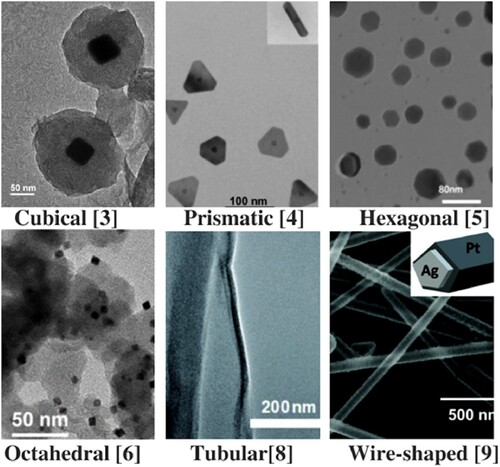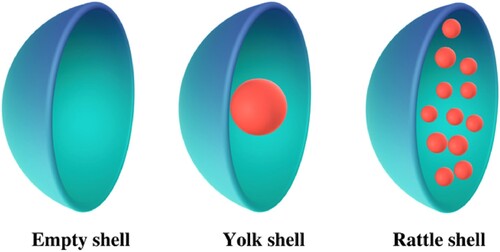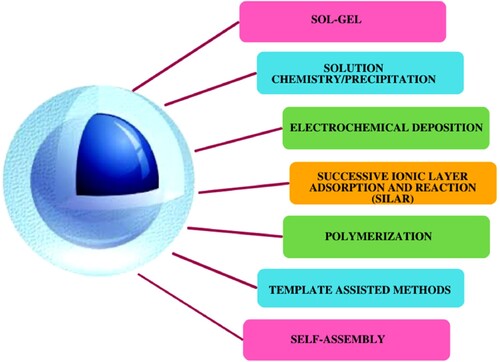The formal study of core-shell particles may be traced back to the late sixties in the development of a novel sorbent of HPLC comprising porous spherical soft shells supported by fluid-impermeable glass microspheres [Citation1]. Such ‘pellicular’ structures were found to be more stable at increasing pressures, changing column temperatures, and eluent compositions than conventional monolithic soft sorbents. Since then, many core-shell-type particles have been designed for various purposes because such composite particles exhibit the combined properties of the core and shell materials.
The study of core-shell particles has expanded exponentially in the past few decades, given the variety of structures possible and the vast gamut of applications they can support (). The composites that have been studied have been of various constituents, gross sizes, relative sizes, and morphologies (). While the shell is almost always solid, the cores contain solids, liquids (capsules), or gases (hollow particles). These composite nanoparticle cores and shells have been in various combinations of inorganic, organic, polymeric, and crystalline materials. The entire ensembles have been nanometric or micrometric in size. The core has comprised single particles or multiple ones, and shells that have been studied have been continuous, multi-layered, or discontinuous domains. These particles themselves have been of various shapes as well.
Morphology-based classification of core-shell particles
The particle sizes of core-shell structures have varied from nanometric to micrometric dimensions. The size factor is particularly important for biomedical applications such as drug delivery in which the drug molecules are encapsulated by a biocompatible/biodegradable shell. The advantages of micronized core-shell particles as drug carriers are the higher encapsulation efficiency and protection possible with the thicker shells than with the relatively finer shells in nanosized particles. However, nanosized core-shell particles can carry a higher payload and release the drug faster with a more direct ‘burst’ release, which makes core-shell nanocapsules relevant in fast-release drug applications. Thus, while micrometer-sized particles are ideal as a long-term reservoir of drugs upon local administration, nanometric particles are better suited for the rapid and targeted delivery of drugs. Nanometric capsules are also effective carriers of biomolecules such as DNA and RNA fragments that must be introduced into cells that cannot be penetrated by larger micrometer-sized particles.
On the other hand, micrometer-sized core-shell particles are suited for the design of ‘artificial cells’ because of the possibility of having multiple compartments encapsulated by a common shell, similar to living cells ().
Figure 3. An example of a core-shell structured artificial cell. Image adapted from Ref. [Citation2].
![Figure 3. An example of a core-shell structured artificial cell. Image adapted from Ref. [Citation2].](/cms/asset/46833c39-c5a9-47f3-a496-9cb44c50c7aa/ysue_a_2170550_f0003_oc.jpg)
The core-shell particles are of numerous shapes beyond spherical; cubical [Citation3], prismatic [Citation4], hexagonal [Citation5], octahedral [Citation6], disc-like [Citation7], tubular [Citation8], and wire-shaped [Citation9], core-shell nano and microparticles have been studied (). The anisotropy of their morphology has led to unique catalytic [Citation10], optical [Citation10], magnetic [Citation11], and electrical [Citation12] properties.
Composition-based classification of core-shell particles
Apart from the physical state (solid/liquid/gas), core-shell particles may be inorganic/inorganic, inorganic/organic [Citation13], organic/inorganic, and organic/organic materials. The choice of the core and shell materials depends upon the end application.
Inorganic–organic core/shell nanoparticles are typically studied for their unique electrical and magnetic properties, wherein the core inorganic particle has the desired property and the shell of an organic compound allows it to be incorporated in organic-based matrices. Such composite particles are used in displays, batteries, optical sensors, magnetic imaging applications, etc. When the organic shell is an electrical conductor, like PANI, core-shell composites find use in transparent electronics, light emitters, light absorbers (), piezoelectric devices, microwave absorbers, chemical sensors, and spin electronics.
Figure 5. An example of inorganic core-organic shell particles for use in light emitting and light absorption devices. Image reproduced without modification from [Citation14].
![Figure 5. An example of inorganic core-organic shell particles for use in light emitting and light absorption devices. Image reproduced without modification from [Citation14].](/cms/asset/2eb86041-d1f3-4799-a1e0-3010f173c5d5/ysue_a_2170550_f0005_oc.jpg)
Bimetallic core-shell nanoparticles have shown improved magnetic [Citation15], catalytic [Citation16], and optics [Citation17] properties for a variety of applications. The segregation phenomena have dictated the structure and properties of multi-metallic core-shell structures (). Simulation studies have shown that the surface segregation in the bimetallic combinations depends on the cohesive energy and Wigner–Seitz radius of the two metals in the core-shell structure [Citation18].
Figure 6. Four types of structures possible as seen from molecular dynamics (MD) and Monte Carlo (MC) simulations for 50:50 bimetallic composition. Image adapted from Ref. [Citation18].
![Figure 6. Four types of structures possible as seen from molecular dynamics (MD) and Monte Carlo (MC) simulations for 50:50 bimetallic composition. Image adapted from Ref. [Citation18].](/cms/asset/f2e91740-2476-49f5-809b-132f6af6f4d9/ysue_a_2170550_f0006_oc.jpg)
Hollow nanostructures, which are essentially core-shell particles in which the shell encapsulates an empty or partially filled space, are also of significant academic interest because the presence of the cavities results in the reduction of the density compared to the dense solid counterparts for equal volumes of materials'. Hollow nanoparticles with empty or partially filled cores () have been studied for use as catalytic hollow nanoreactor systems with high activity, selectivity, and recyclability. The shells are usually permeable, and allow only specific substrate molecules to access the interior cavity that houses the catalytic site, thereby enabling substrate-selective catalysis. Such nanoreactor cores are usually made of noble metals and their alloys, or magnetic/transition metal oxides, and the shells are made of ceramic oxide materials or carbon-based materials, such as amorphous carbon and reduced graphene oxide, and organic polymers [Citation19].
Synthesis of core-shell particles
Core-shell particles have been synthesized by bottom-up approaches by which the core particles are formed followed by envelope formation. Chemical synthesis, chemical vapour deposition, laser-induced assembly, self-assembly, colloidal aggregation, film deposition, and growth, are some of the methods commonly reported in the literature. A comprehensive review of various synthesis methods for various kinds of core-shell particles was published in 2012 [Citation20]. Since then, the field of core-shell particulate materials has grown so vast that no single review can provide a complete picture of the synthesis methods. A recent review [Citation21] summarizes some of the recent trends in the area of core-shell systems. Almost all synthesis methods reported fall under the categories represented in .
The application areas of core-shell particles are numerous. The main areas of study of core-shell structures have been
Biomedical (molecular imaging, drug delivery, and therapy) [Citation22];
Energy (supercapacitors, li-ions batteries, hydrogen storage systems, quantum dot solar cells, dye-sensitized solar cells, silicon/organic solar cells, and fuel cells) [Citation23];
Catalysis (photocatalysis, electrocatalysis, bimetallic catalysis) [Citation24Citation25] and
Photonics [Citation26].
In many applications that require nanostructured particles to impart specialized properties such as superhydrophobicity [Citation27], lubrication [Citation28], corrosion resistance [Citation29], etc., core-shell particles are used to stabilize the nanoparticles and prevent aggregation. Thus, while the core-shell structure in itself does not contribute to the property sought, it plays a supporting role. In some cases, the core shell approach provides for easier sintering.
An interesting approach to self-healing structures has been to encapsulate healing agents inside micron-sized or nanosized capsules that break to release the healing agents. Scopus lists 71 papers in 2022 alone, on the use of core-shell particles for self-healing coatings and other applications.
Biomedical and energy applications can be expected to drive future developments in core-shell-type particles. The ability to converge different properties into a single system offers tremendous scope for new materials development required for futuristic applications.
References
- Horvath C, Lipsky SR. Column design in high pressure liquid chromatography. J Chromatogr Sci. 1969 Feb;7(2):109–116.
- Niederholtmeyer H, Devaraj N. Gene expression in a synthetic eukaryotic cell-mimic. The FASEB J. 2018 Apr;32(S1).
- Verma S, Tirumala Rao B, Jayabalan J, et al. Studies on growth of Au cube-ZnO core-shell nanoparticles for photocatalytic degradation of methylene blue and methyl orange dyes in aqueous media and in presence of different scavengers. J Environ Chem Eng. 2019 Aug;7(4):103209.
- Xue C, Millstone JE, Li S, et al. Plasmon-Driven synthesis of triangular core–shell nanoprisms from gold seeds. Angew Chem Int Ed. 2007 Nov;46(44):8436–8439.
- Padervand M, Asgarpour F, Akbari A, et al. Hexagonal core–shell SiO2[–MOYI]Cl–]Ag nanoframeworks for efficient photodegradation of the environmental pollutants and pathogenic bacteria. J Inorg Organomet Polym Mater. 2019 Jul;29(4):1314–1323.
- Xie M, Lyu Z, Chen R, et al. Pt–Co@Pt octahedral nanocrystals: enhancing their activity and durability toward oxygen reduction with an intermetallic core and an ultrathin shell. J Am Chem Soc. 2021 Jun;143(22):8509–8518.
- Beyene G, Senbeta T, Mesfin B, et al. Plasmonic properties of spheroidal spindle and disc shaped core–shell nanostructures embedded in passive host-matrices. Opt Quantum Electron. 2020 Mar;52(3):157.
- Liu Y-C, Hung Y-H, Guo C-H, et al. Core–shell structured multiwall carbon nanotube–graphene oxide nanoribbon and its N-doped variant as anodes for high-power microbial fuel cells. Sustain Energy Fuels. 2020;4(10):5339–5351.
- Koylan S, Koylan S, Tunca S, et al. Highly stable silver–platinum core–shell nanowires for H 2 O 2 detection. Nanoscale. 2021;13(30):13129–13141.
- Sweeney CM, Hasan W, Nehl CL, et al. Optical properties of anisotropic core−shell pyramidal particles. J Phys Chem A. 2009 Apr;113(16):4265–4268.
- Wang J, Or SW. Orientation-induced enhancement in electromagnetic properties of ZnFe 2 O 4 /SiO 2 /PANI core/shell/shell nanostructured disks. AIP Adv. 2016 May;6(5):055908.
- Liu B-T, Huang S-X, Lai M-F, et al. Synthesis of Ag–Ni core–shell nanowires and their application in anisotropic transparent conductive films. RSC Adv. 2015;5(3):1684–1689.
- Chiozzi V, Rossi F. Inorganic–organic core/shell nanoparticles: progress and applications. Nanoscale Adv. 2020;2(11):5090–5105.
- Kim T, Kang H, Jeong S, et al. Au@polymer core–shell nanoparticles for simultaneously enhancing efficiency and ambient stability of organic optoelectronic devices. ACS Appl Mater Interfaces. 2014 Oct;6(19):16956–16965.
- Liu F, Zhu J, Yang W, et al. Building nanocomposite magnets by coating a hard magnetic core with a soft magnetic shell. Angew Chem Int Ed. 2014 Feb;53(8):2176–2180.
- Ullah S, Ferreira-Neto EP, Pasa AA, et al. Enhanced photocatalytic properties of core@shell SiO2@TiO2 nanoparticles. Appl Catal B. 2015 Dec;179:333–343.
- Lim J, Jeong BG, Park M, et al. Influence of Shell Thickness on the Performance of Light-Emitting Devices Based on CdSe/Zn 1-X Cd X S Core/Shell Heterostructured Quantum Dots. Adv Mater. 2014 Dec;26(47):8034–8040.
- Eom N, Messing ME, Johansson J, et al. General trends in core–shell preferences for bimetallic nanoparticles. ACS Nano. 2021 May;15(5):8883–8895.
- Lee J, Kim SM, Lee IS. Functionalization of hollow nanoparticles for nanoreactor applications. Nano Today. 2014 Oct;9(5):631–667.
- Chaudhuri RG, Paria S. Core/shell nanoparticles: classes, properties, synthesis mechanisms, characterization, and applications. Chem Rev. 2012 Apr;112(4):2373–2433.
- Singh R, Bhateria R. Core–shell nanostructures: a simplest two-component system with enhanced properties and multiple applications. Environ Geochem Health. 2021 Jul;43(7):2459–2482.
- Chatterjee K, Sarkar S, Jagajjanani Rao K, et al. Core/shell nanoparticles in biomedical applications. Adv Colloid Interface Sci. 2014 Jul;209:8–39.
- Feng H, Tang L, Zeng G-m, et al. Core-shell nanomaterials: Applications in energy storage and conversion. Adv Colloid Interface Sci. 2019 May;267:26–46.
- Jiang R, Tung So, Tang Z, et al. A review of core-shell nanostructured electrocatalysts for oxygen reduction reaction. Energy Storage Mater. 2018 May;12:260–276.
- Shafiee A, Rabiee N, Ahmadi S, et al. Core–shell nanophotocatalysts: review of materials and applications. ACS Appl Nano Mater. 2022 Jan;5(1):55–86.
- Khudiyev T. Core-shell nanostructures for photonics applications: Optical core-shell nanostructures. LAP LAMBERT Academic Publishing; 2016.
- Kim S-H, Kang HS, Sohn E-H, et al. A strategy for preparing controllable, superhydrophobic, strongly sticky surfaces using SiO 2 @PVDF raspberry core–shell particles. RSC Adv. 2021;11(38):23631–23636.
- Hong FT, Schneider A, Sarathy SM. Enhanced lubrication by core-shell TiO2 nanoparticles modified with gallic acid ester. Tribol Int. 2020 Jun;146:106263.
- Hu J, Zhu Y, Hang J, et al. The effect of organic core–shell corrosion inhibitors on corrosion performance of the reinforcement in simulated concrete pore solution. Constr Build Mater. 2021 Jan;267:121011.





